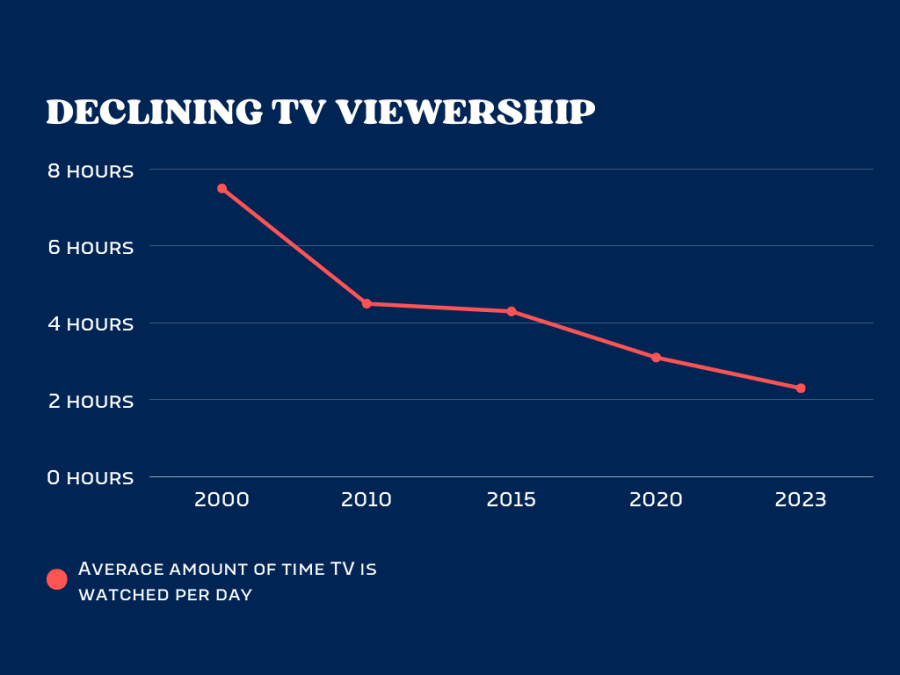Pulled Plugs: The way media is consumed is changing, and the TV industry has started dying because of it.
June 5, 2023
Television is slowly becoming a relic of the past. From the 50’s all the way to the 2010’s, you could find a family from anywhere in the world together watching whatever happened to be broadcasted that night. In recent years however, people have been gravitating away from the TV, and its content has steadily started to drift off from the public eye.
People have been very upset with the current state of TV. Between television prices rising, people having more trouble focusing on shows, and most current content not catching the public’s eye, many have turned away from television without looking back. According to an article written by Andrews University student Elizabeth Getahun, our ever-growing use of technology has made it harder for people to focus.
“With technological advances and an increase in media consumption, especially social media, it seems that concentration has become increasingly difficult and attention spans are shortening,” Getahun said.
The constant decrease of attention has been a major cause of the decline in TV viewership in the United States. The main cause to our shorter attention spans has been attributed to our brains being overloaded with both information and stimulation. In an era where most people have easy access to the internet, with around 85% of the world owning a smartphone, we can find boatloads of information in seconds. This change in human behavior has led to a shift in media consumption. A study by the Consumer Technology Association, an organization that represents tech companies, showed that the amount of time consumers spend watching social media content is almost as big as traditional TV content. Andrew Hutchinson of Social Media Today wrote an article discussing the study, displaying the opinion that popular forms of media are changing and will most likely continue to change.
“The data underlines the evolving shift away from traditional media, and towards more democratized social media platforms as the key form of content consumption,” Hutchinson said. “Younger consumers are far more aligned with individual creators that they find and subscribe to, and that is a key daily consumption trend to note.”
The costs of streaming services have increased greatly throughout the past decade. While they were originally seen as a cheaper and more efficient alternative to cable, the prices for most streaming services have either hit or surpassed the prices of most cable providers. In 2011, a standard Netflix subscription only cost $7.99. That number has nearly doubled in price since then, jumping up to $13.99. If you pair this with the fact that Netflix continues to remove beloved shows from their platform and the fact that there have been talks of adding commercials for lower subscription tiers, there are less and less reasons to keep a Netflix subscription nowadays. Netflix reported that they lost 1.2 million subscribers in 2022. There are many indicators showing that people are unhappy with the spike in pricing. Storywriter Emma Roth of The Verge wrote an article voicing concerns about Netflix’s future.
“The truth is, this trend isn’t going to stop anytime soon. Streaming services need to raise their prices or embrace advertising if they want to meet investors’ expectations,” Roth said. “They’re just going to have to risk losing subscribers who don’t want to pay these jacked-up prices along the way.”
The biggest reason for the declining state of TV viewership, however, is easily the most obvious reason. People simply aren’t interested in watching TV shows anymore. A study run by the Office of Communications, a UK based communications regulator, found that people between the ages 16 to 24 spend less than an hour a day watching TV. I’ve found that it’s hard to stay captivated and entertained by longer-form shows, with many opting to have hour long episodes. Younger individuals have a tendency to lean towards getting entertainment from the internet, with a reported 14% of people choosing to watch TV as their first option. Esther Crowder, a writer for the internet based American organization Cyberwise, found specific reasons for the lack of interest amongst teens.
“Most teenagers claim that the content that TV provides them is uninteresting. YouTube contains more quality, entertaining, educational content,” Crowder said. “The duration of YouTube videos is usually shorter than a television show, making it easy to hold a teens’ attention. Moreover, you can pause long videos and continue watching later.”
Television as a whole is losing interest of many people, mainly the youth, globally. All across the world, we are seeing numbers in viewership decrease for both live cable companies and streaming services. The way media is consumed has been shifting to social media, and if these statistical trends continue the TV industry may not be able to recover.



